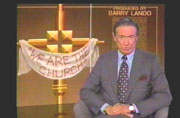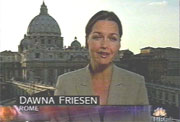The Life of Pope John Paul:
Table of Contents:
- The Life of Pope John Paul:
- Introduction
- 1. The "Communist Pope"?
- 2. John Paul vs. Conservatism
- 3. Liberals vs. John Paul
- 4. "Catholics" vs. Catholicism
- 5. Conclusion
4. "Catholics" vs. Catholicism
 When discussing “reform” of the Catholic Church in the last
quarter-century, the secular, politically minded liberal media
establishment often demanded religion by ballot, with no room for
sacred traditions, and no awe for an “authoritarian” God. TV coverage
suggested the public should only hear the views of the Church’s
attackers; reporters had little use for traditionalists. It’s one thing
to describe a church conflict with a fair and balanced approach. But
the media glorified and enlarged the influence of dissenters,
constantly identifying and quoting what they called the “many
Catholics” who agreed with their worldview.
When discussing “reform” of the Catholic Church in the last
quarter-century, the secular, politically minded liberal media
establishment often demanded religion by ballot, with no room for
sacred traditions, and no awe for an “authoritarian” God. TV coverage
suggested the public should only hear the views of the Church’s
attackers; reporters had little use for traditionalists. It’s one thing
to describe a church conflict with a fair and balanced approach. But
the media glorified and enlarged the influence of dissenters,
constantly identifying and quoting what they called the “many
Catholics” who agreed with their worldview.
On May 4, 1990, NBC Nightly News anchor Tom Brokaw covered the Pope’s trip to Mexico, “a country where there’s a huge population problem. Many people say that problem is magnified by the Church’s opposition to birth control.” Reporter George Lewis found anonymous “experts” to disparage the Church: “Family planning experts say that ignorance and superstition play a big role in Mexico’s population crisis...they also say the Catholic Church has to share the blame.”
When Pope John Paul came to Denver in 1993 for World Youth Day, the most biased TV story from the trip came on the CBS show Sunday Morning on August 8. Reporter Jerry Bowen presented 13 soundbites of papal critics and dissenters, compared to just two from Denver Archbishop Francis Stafford. Critics included a nun, Sister Mary Luke, who said the church must have female priests and rid the Church of “this kind of patriarchy”; a divorced mom, Leanna Day (“It’s real strict and real rigid, and we can’t, we don’t live a real strict and rigid life”); Day’s liberal priest, Father John Burton (“The Church either changes with the world, or it’s left as a museum piece”) and Jim Beeten, a former seminarian who quit because he refused to remain celibate. Bowen defended his story to the MRC’s MediaWatch at the time as full of “very devout Catholics.” This was typical of TV coverage of the trip: an MRC count of 14 network stories on the papal visit found 57 soundbites criticized church teaching, while only 27 defended it.
A week later on the same program, Jerry Bowen concluded: “There are some who say he would have been more comfortable in the 5th century, but some theologians say that really, some of the 5th century Popes were more progressive than John Paul II.” When MediaWatch asked whether Bowen had studied the 5th century Popes or what theologians said to him, he insisted it was a joke: “These are comments that are made in less of a scholarly vein...I think it’s a light-hearted observation.” He added: “I didn’t think of it as being anti-John Paul or anti-Pope.”
On January 22, 1995, the CBS show 60 Minutes devoted an entire segment to promoting the left-wing group Call To Action, beginning with the “many Catholics” line: “Among the things they challenge is the Pope’s position on birth control, on women becoming priests, and on priests being able to marry....There’s no denying that for many American Catholics, those teachings have lost their appeal.”
Father Mike Flager denounced the Church as “spiritually bankrupt” and said the traditional Church has “a love it or leave it, you know, it’s that crazy patriotism philosophy.” Edwina Gately “was described as a devout Catholic with the tongue of a pagan tart.” Gately replied with a smile: “Well, I’m OK with the ‘pagan tart,’ it’s the ‘devout Catholic’ that worries me.” Wallace reminded her she once said “the Vatican is the only tyranny left in the world today.” But Wallace insisted his subjects were “hardly wild-eyed radicals, these people from Call to Action. They’re sober church workers, nuns and priests, and just plain concerned Catholics... their ideals formed in the heady age of change back in the ‘60s.”
Wallace’s report included 25 soundbites from the “dissidents” without broadcasting a single voice in favor of traditional Catholicism. Wallace later conceded to the Catholic newspaper Our Sunday Visitor that “interviews with Harvard law professor Mary Ann Glendon and George Weigel of the Ethics and Public Policy Center, prominent lay Catholics who support Church teaching, were not used because producers felt the material was too dissimilar to work with footage from the Call to Action conference.” They were also “too dissimilar” with CBS thinking.
Several magazine clips aptly illustrate the media’s liberal “reform” impulse from outside the world of religion. In a June 18, 1999 feature titled “A Closer Look,” Time magazine’s Web site revisited a favorite pejorative ‘R’ word as related to the Pope. The subheadline read, “As the millennium ends, the era of John Paul II draws to a close. And soon the Vatican must decide how much of the Polish Pope’s revolution — and his rigidity — it wants to keep.”
 Reporter Frank Pellegrini complained: “The enormous
charisma of the man has made zealots of the converted and converts of
the heathen, but John Paul II has brooked no heretics.... it is
impossible to call John Paul II anything other than a conservative. He
does not take to new currents in Catholicism, and has displayed a ready
pen for excommunication. He is stoutly against birth control,
abortions and female priests, and has similarly held the line on
remarriage after divorce, annulments and celibacy in the
priesthood....When the Pope comes to the [United] States, nuns argue
with him, liberal Catholics tug at their collars nervously, and
liberated women grouse.”
Reporter Frank Pellegrini complained: “The enormous
charisma of the man has made zealots of the converted and converts of
the heathen, but John Paul II has brooked no heretics.... it is
impossible to call John Paul II anything other than a conservative. He
does not take to new currents in Catholicism, and has displayed a ready
pen for excommunication. He is stoutly against birth control,
abortions and female priests, and has similarly held the line on
remarriage after divorce, annulments and celibacy in the
priesthood....When the Pope comes to the [United] States, nuns argue
with him, liberal Catholics tug at their collars nervously, and
liberated women grouse.”
Like many other reporters, Pellegrini could not understand why the Pope wouldn’t run his church like a focus group: “It is a Catholicism that stands, on the ideological spectrum, far to the right of what many of even its devotees would like it to be, and thanks to John Paul’s appointees it is not likely to budge. In answer to the forces of liberalism, John Paul II has stacked the deck.”
In her Web-exclusive column on March 29, 2002, Newsweek’s Eleanor Clift perfectly distilled how the media see the world through secular and political eyes. Clift began: “Congress has made some changes, and maybe the church can, too.” In what may be a first for liberals, Clift suggested an end to a centralized bureaucracy: “The papacy as we know it, is a 19th-century convention. The idea that in an age of e-mail and fax, and the ability to whisk around the globe in jets, everybody kowtows to a central figure seems quaint.” Clift also banged the drum for an end to priestly celibacy: “The priesthood attracts sexually conflicted men, and the church will have to face up to that as a potentially criminal matter, not as a way to perpetuate an outdated custom of celibacy.”
 On the 25th anniversary of Pope John Paul’s reign came
in October of 2003, the liberal line – “many Catholics” vs. the
intransigent Pope – emerged again. On the October 12 NBC Nightly News,
reporter Dawna Friesen emphasized: “For some, the celebrations will be
bittersweet. The Pope’s conservative views on abortion, contraception,
divorce, woman priests and homosexuality have alienated many
Catholics, as did the sex abuse scandals involving priests.” But
Friesen ended with a Wisconsin woman, Mary Sadarno, who said being in
the Pope’s presence reaffirmed her faith.
On the 25th anniversary of Pope John Paul’s reign came
in October of 2003, the liberal line – “many Catholics” vs. the
intransigent Pope – emerged again. On the October 12 NBC Nightly News,
reporter Dawna Friesen emphasized: “For some, the celebrations will be
bittersweet. The Pope’s conservative views on abortion, contraception,
divorce, woman priests and homosexuality have alienated many
Catholics, as did the sex abuse scandals involving priests.” But
Friesen ended with a Wisconsin woman, Mary Sadarno, who said being in
the Pope’s presence reaffirmed her faith.
On the October 12, 2003 This Week with George Stephanopoulos, the host questioned liberal Catholic priest and magazine editor Father Thomas Reese from the left: “Many of the Pope’s critics have a hard time reconciling his outspoken championing of human rights, of human dignity with what they see as his somewhat authoritarian, antiquated view of women and sexuality.” He also asked: “The Pope has held the line on women clergy and this has made many of his critics say he simply doesn’t get it when it comes to women.”
ABC’s Cokie Roberts then elaborated on the liberal theme: “You can feel very left out when you approach an institution that is completely male-dominated and hierarchical. It’s bad enough in this country, where at least we have women on the altar doing readings and girls on the altar as servers. When you actually go the Vatican in Rome, at St. Peter’s there’s not a woman in sight around the altar, there’s not a lay person in sight, and there’s a sense of alienation, there’s no question about that. You really have to say to yourself, ‘this is my church despite that.’” ABC asked only five people to offer opinions on John Paul’s legacy: Reese, Roberts, former Vatican Ambassador and Congresswoman Lindy Boggs (Cokie’s mother), Cardinal Oscar Rodriguez of Honduras, and, for non-Catholics, Mikhail Gorbachev.
CBS reporter Allen Pizzey summed up the occasion on the Evening News of October 16, 2003 with the usual emphasis on the many “flaws” (read: conservatism) of the Pope: “He helped end communism, reached out to Muslims by entering a mosque, sought reconciliation with the Jews by praying at the Wailing Wall....but his legacy is not without flaws. His staunch refusal to ordain women as priests and rigorous rejection of birth control, abortion and homosexuality, have alienated many.”
Notice that in the media argot, cafeteria Catholics never “alienate” other members of the Church, and are not to be described as “divisive.” Only conservatism alienates and divides.



